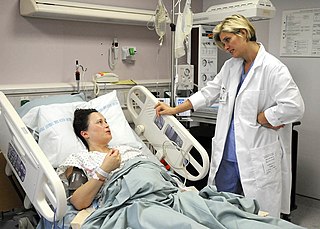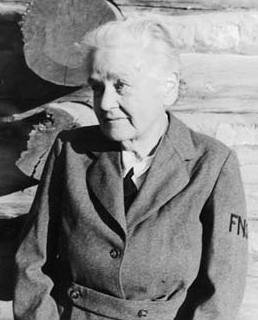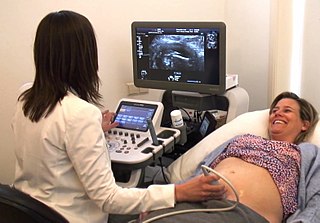Related Research Articles

Midwifery is the health science and health profession that deals with pregnancy, childbirth, and the postpartum period, in addition to the sexual and reproductive health of women throughout their lives. In many countries, midwifery is a medical profession. A professional in midwifery is known as a midwife.

A home birth is a birth that takes place in a residence rather than in a hospital or a birthing center. They may be attended by a midwife, or lay attendant with experience in managing home births. Home birth was, until the advent of modern medicine, the de facto method of delivery. The term was coined in the middle of the 19th century as births began to take place in hospitals.

Unassisted childbirth (UC) refers to the process of intentionally giving birth without the assistance of a medical birth attendant. It may also be known as freebirth, DIY (do-it-yourself) birth, unhindered birth, and unassisted home birth. Unassisted childbirth is by definition a planned process, and is thus distinct from unassisted birth due to reasons of emergency, lack of access to a skilled birth attendant, or other. It is also different from homebirth, although most UCs also happen within the home.

In the United States, a Certified Nurse-Midwife (CNM) is a nurse midwife who exceeds the International Confederation of Midwives' essential competencies for a midwife and is also an advanced practice registered nurse, having completed registered nursing and midwifery education leading to practice as a nurse midwife and credentialing as a Certified Nurse-Midwife. CNMs provide care of women across their lifespan, including pregnancy and the postpartum period, and well woman care and birth control. Certified Nurse-Midwives are recognized by the International Confederation of Midwives as a type of midwife in the U.S.
The Midwives Alliance of North America (MANA) was founded in April 1982 to build cooperation among midwives and to promote midwifery as a means of improving health care for North American women and their families. Its stated goal is to unify and strengthen the profession of midwifery, thereby improving the quality of health care for women, babies, and communities.

The Frontier Nursing Service (FNS) provides healthcare services to rural, underserved populations since 1925, and educates nurse-midwives since 1939.

Mary Carson Breckinridge was an American nurse midwife and the founder of the Frontier Nursing Service (FNS), which provided comprehensive family medical care to the mountain people of rural Kentucky. FNS served remote and impoverished areas off the road and rail system but accessible by horseback. She modeled her services on European practices and sought to professionalize American nurse-midwives to practice autonomously in homes and decentralized clinics. Although Breckinridge's work demonstrated efficacy by dramatically reducing infant and maternal mortality in Appalachia, at a comparatively low cost, her model of nurse-midwifery never took root in the United States.
A birth attendant, also known as skilled birth attendant, is a health professional who provides basic and emergency care to women and their newborns during pregnancy, childbirth and the postpartum period. A birth attendant, who may be a midwife, physician, obstetrician, or nurse, is trained to be present at ("attend") childbirth, whether the delivery takes place in a health care institution or at home, to recognize and respond appropriately to medical complications, and to implement interventions to help prevent them in the first place, including through prenatal care. Different birth attendants are able to provide different levels of care.
Childbirth Connection, formerly known as the Maternity Center Association, is an American national nonprofit organization that works to improve the quality of maternity care through research, education, advocacy, and policy. Childbirth Connection promotes safe, effective evidence-based maternity care and is a voice for the interests of childbearing women and families.
Ruth Watson Lubic, CNM, EdD, FAAN, FACNM, is an American nurse-midwife and applied anthropologist who pioneered the role of nurse-midwives as primary care providers for women, particularly in maternity care. Lubic is considered to be one of the leaders of the nurse-midwifery movement in the United States.
Childbirth in rural Appalachia has long been a subject of concern amongst the population because infant mortality rates are higher in Appalachia than in other parts of the United States. Additionally, poor health in utero, at birth, and in childhood can contribute to poor health throughout life. The region's low income, geographic isolation, and low levels of educational attainment reduce both access to and utilization of modern medical care. Traditional medical practices, including lay midwifery, persisted longer in Appalachia than in other U.S. regions.
Midwives in the United States assist childbearing women during pregnancy, labor and birth, and the postpartum period. Some midwives also provide primary care for women including well-woman exams, health promotion, and disease prevention, family planning options, and care for common gynecological concerns. Before the turn of the 20th century, traditional midwives were informally trained and helped deliver almost all births. Today, midwives are professionals who must undergo formal training. Midwives in the United States formed the Midwifery Education, Regulation, and Association task force to establish a framework for midwifery.

A direct-entry midwife is a midwife who has become credentialed without first becoming a nurse. There are direct-entry midwifery programs that prepare students to become Certified Nurse Midwives (CNMs) or Certified Professional Midwives (CPMs). Certified Professional Midwives are known for being "more natural and less intervention oriented." In other words, these midwives typically work outside of the hospital setting in homes and birth centers and do not employ methods for childbirth that physicians in hospitals commonly use such as caesarean section, forceps and other types of equipment and drugs.

A midwife is a health professional who cares for mothers and newborns around childbirth, a specialization known as midwifery.

Ronnie Sue Lichtman, is a midwife, educator, writer and advocate for women's health. She has published widely for both lay and professional audiences. The Chair of the Midwifery Education Program at The State University of New York (SUNY) Downstate Medical Center in New York City, she earned a Ph.D. in sociomedical sciences from Columbia University Graduate School of Arts and Sciences, and her MS in Maternity Nursing with a specialization in midwifery from Columbia University School of Nursing. She previously directed the midwifery programs at Columbia University and Stony Brook University.

A nurse midwife is both a nurse and a midwife, having completed nursing and midwifery education leading to practice as a nurse midwife and sometimes credentialed in the specialty. Nurse midwives provide care of women across the lifespan, including during pregnancy and the postpartum period, and well woman care and birth control.

Victoria Joyce Ely was an American nurse who served in World War I in the Army Nurse Corps and then provided nursing services in the Florida Panhandle in affiliation with the American Red Cross. To address the high infant and maternal death rates in Florida in the 1920s, she lectured and worked at the state health office. Due to her work, training improved for birth attendants and death rates dropped. After 15 years in the state's service, she opened a rural health clinic in Ruskin, Florida, providing both basic nursing services and midwife care. The facility was renamed the Joyce Ely Health Center in her honor in 1954. In 1983, she was inducted into Florida Public Health Association's Hall of Memory and in 2002 was inducted into the Florida Women's Hall of Fame.
Eunice Katherine Macdonald "Kitty" Ernst was an American nurse midwife and leader in the nurse-midwife movement in the United States.
Midwives in South Africa are nurses who focus on the care of pregnant women and the delivery of babies. Midwives have the ability to work independently in cases of healthy pregnancies and problem-free deliveries; however, they can refer patients to gynaecologists or obstetricians when complications are diagnosed. The majority of pregnant women in South Africa use the public healthcare system, and most of this care is provided by midwives.

The American College of Nurse-Midwives (ACNM) is a professional association in the United States, formed in 1955, that represents certified nurse-midwives (CNMs) and certified midwives (CMs). Dating back to 1929, ACNM strives to be a leading example for excellence in midwifery education and practice in the United States and has a special interest in promoting global health in developing countries. "Members are primary care providers for women throughout the lifespan, with a special emphasis on pregnancy, childbirth, and gynecologic and reproductive health. ACNM reviews research, administers and promotes continuing education programs, and works with organizations, state and federal agencies, and members of Congress to advance the well-being of women and infants through the practice of midwifery."
References
- ↑ "Become a midwife". American College of Nurse-Midwives. Retrieved 10 June 2020.
- ↑ "The Credentials CNM and CM". American College of Nurse-Midwives (ACNM). Retrieved 10 June 2020.
- 1 2 3 4 5 6 "Comparison of Three Types of Midwifery Certification", American College of Nurse-Midwifery, August 2011.
- 1 2 3 4 5 "ACNM Position Statement", 'American College of Nurse-Midwifery, March 2009.
- ↑ "FAQs for Prospective Students", American College of Nurse-Midwifery, 2010.
- 1 2 3 "ACNM Compensation and Benefits Survey 2007", American College of Nurse-Midwifery, 2007.
- 1 2 NCHS Data Brief: Home Births in the United States, 1990–2009, Centers for Disease Control and Prevention , January 2012.
- 1 2 Kazak, Kelly. Goal of Huntsville Walk 4 Midwives is to change law prohibiting at-home births with midwives , Al.com Blogs, October 21, 2012.
- 1 2 Valdes, Gustavo and Catherine E. Shoichet. Midwife birth certificates tied to immigration problems along Texas border, CNN , June 5, 2012.
- 1 2 3 4 5 6 7 8 9 10 Litoff, Judy Barrett, The America Midwife Debate: A Sourcebook on Its Modern Origins. Westport, Connecticut: Greenwood Press, 1986.
- 1 2 3 4 5 6 7 8 9 10 11 12 13 14 15 16 Ettinger, Laura E., Nurse-Midwifery: The Birth of a New American Profession. Columbus, Ohio: The Ohio State University Press, 2006.